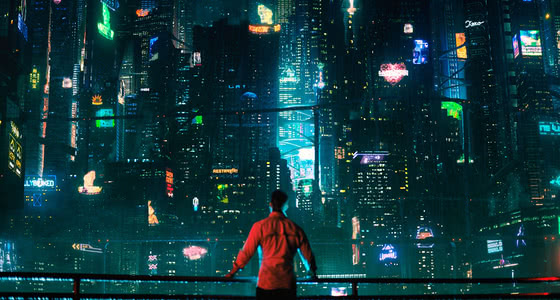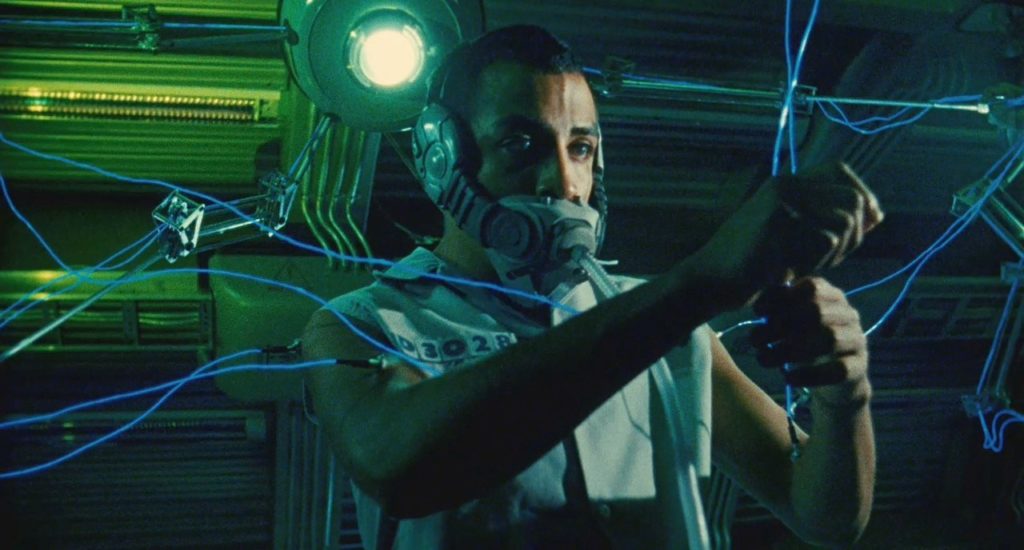Cyberpunk’s Commodification of Bodies
The genre of science fiction is not the most reliable source for predicting the future. And yet, when one engages in prophecy, be it political, social, ecological, or economic, science fiction seems to be a staple for the visualization of one’s prognostication. In fact, culturally speaking science fiction seems to be our most reliable resource to drive home the point that purely statistical predictions are unable to transport to mainstream audiences.
Take for example, the 2 degrees of global warming that we have all been warned will have massive effects on weather patterns, threatening, for example, more intensity in rainfall and storms. But only the science fictional imagination is able to package this, so that it hits home. Films such as Geostorm or The Day after Tomorrow are drastic representations of climate effects and will produce more debate and interest in climate science than any reporting on the Paris accords. It seems then, that the sf imagination is a pretty good indicator of both the challenges we will face and the solutions that might be possible.
This is, of course, not only true of climate change but also of other pressing issues such as globalization, automatization, or social inequality—all of these topics, including climate change and its results, are touched upon by the thought experiments that sociologist Pete Frase presents in his book Four Futures. Frase describes the possible future world shaped by automatization—his (only in its extremity somewhat science-fictional) premise is that capitalism as we know it will no longer exists, mostly because we will automate work and thus potentially free humans from labor. He then continues by arguing that our future will be determined by two factors: “the first axis dictates the economic base of the post-capitalist future, while the second pertains to the socio-political superstructure” (“Four Futures”, n.pag.). On the one hand, then, our future will be determined by our continued access to natural resources, to the Earth’s ability to sustain our need for raw materials. On the other hand, our future will be determined by our determination to keep or to eradicate social inequality—the question of our division by classes, however these are constituted. He sums up that we will have the choice of four futures determined by these two axes: “Two possible futures are socialisms […] while the other two are contrasting flavors of barbarism” (“Four Futures”, n.pag.).
Now, taking into consideration the depiction of futures in science fiction, especially in the subgenre of cyberpunk, one could argue that an oft depicted and not quite so unlikely scenario is the one described by Frase as “exterminism,” in which workers are no longer needed, as they are replaced by automated processes. But since the scarcity of resources limits the ability for all humans to be wealthy, those with money will face more and more people that cannot participate in society. Frase poignantly calls these people “superfluous from the standpoint of the ruling elite” (“Four Futures”, n.pag.).
In this, he echoes Zygmunt Bauman, who argued that the progression of the capitalist economy—meaning, for example, automatization and globalization—produces “surplus population” (37), people that are no longer needed in economic production. Because they produce no labor and thus earn no money in a “society of consumers, they are ‚flawed consumers’—people lacking the money that would allow them to stretch the capacity of the consumer market” (39). Within the hypercapitalist society of exterminism, Bauman would see these flawed beings as “human waste” (39), a descriptor that expresses the cynical tendency of our society to determine any object according to its economic production value. We are what we earn and consume.
Turning to the science-fictional and especially the cyberpunk imaginary, one could see such an economy of exterminism exemplified in Neil Bloomkamp’s film Elysium. For those who don’t know the film, a short recap of the setup might help: The future sees the planet destroyed by pollution and overpopulation—Los Angeles has become dusty, hot, and decrepit (in terms of production, it looks like Mexico City, where the film was shot). Most humans live in poverty and fight over the scraps of jobs and food. Crime is rampant and people barely manage to survive. Sickness is ever-present and neither medical nor social services are functioning anymore. The ruling elite, though, have escaped to the eponymous orbital station of Elysium and live there, served and secured by robots.
In the mindset of the Elysian elites, the population of Earth is considered somewhere between a nuisance and a threat—echoing the Trumpian rhetoric of the so-called “migrant caravan” or the “bad hombres” from Latin America. For the population of Earth, opportunities are few and far between. Existing jobs (outside of crime or the very exclusive specialized jobs, such as nurses or doctors) are mainly unlearned and unqualified, thus can be fulfilled by anybody (maybe even: any “body”). Workers become exchangeable biomass, cheaper than automated production because they are more expendable. A scene early in the film makes this painfully clear: Max (Matt Damon) is an ex-con and works in such an unskilled job at a factory building robots—the irony of manually producing automated labor is not lost on the viewer here. When the production is halted because of a blocked piece of equipment, his precarious job position does not allow him to refuse an order retrieve the piece from the radiation chamber. He goes in, gets locked in the mechanism and receives a fatal dose of radiation. When he wakes up, a robot is standing over him, informing him in a mechanical voice that he has been lethally poisoned and will die in five days. His boss John Carlyle (William Fichtner) is called, upset about the production halt and detachedly discusses Max’s accident with a foreman. The shot takes Max’s perspective, Carlyle shown through the secure glass barrier, talking about Max and deciding his fate without any consideration for his imminent death. Carlyle shakes his head, looks mildly frustrated at the loss of production time. When the scene cuts back to him, Carlyle asks about Max’s state and whether he will bleed or his skin might fall off. But not compassion is driving this query: “I don’t want to replace the bedding in there, just get him out!” is his order, before he turns back to managing his company. Max is then handed a release form to sign (for which he barely manages a scribble) and some heavy pharmaceuticals that will keep him functioning until his death in five days—when ultimately his body will shut down.
Image 1: Elysium: Max is treated by a robot and made to sign his release form.
What is interesting about work and automation in the film is its insight into the economics of exterminism. Max is an unskilled worker, doing a job that is repetitive, has little complexity, and is in a hazardous environment—a job that in today’s economy seems destined to be automated. Yet, in the future of Elysium, the economy clearly says it is more productive to use human labor than cost intensive automation. Pete Frase links automation to workers’ rights and organizational structures: “This development illustrates a recurrent capitalist dynamic: as workers become more powerful and better paid, the pressure on capitalists to automate increases. When there is a huge pool of low wage migrant farm labor, a $100,000 fruit picker looks like a wasteful indulgence. But when workers are scarce and can command better wages, the incentive to replace them with machinery is intensified“ (Four Futures 8). So, ironically, the fact that human workers can be exploited and exchanged at will, without issues of work conditions or human rights interfering, actually secures these jobs for humans.
On the other end of the spectrum, jobs that involve an understanding of human interactions, jobs that rely on emotional involvement, are today considered relatively safe from automation. But Elysium reveals the logic of exterminism and challenges this idea. Here, police and security forces as well as social caretakers such as Max’s probation officer are automated. For Frase, this is a logical conclusion as the “impoverished, economically superfluous rabble poses a great danger to the ruling class“ (“Four Futures”, n.pag.) and will need to be beaten into submission (as is literally done to Max in the film)—the automation of the forces that control the multitudes is a logical conclusion. And should suppression not suffice any longer, then exterminating this type of “human waste” (to use Bauman’s term) must be the ultimate endpoint.
In between policing the poor as a first step and exterminating them as the final step, stands the idea of what Frase in reference to Bryan Turner calls “enclave society” (“Four Futures”, n.pag.). Enclave societies restrict and regulate “’the flows of people, goods and services’ by means of ‘enclosure, bureaucratic barriers, legal exclusions and registrations” (cit. in “Four Futures”, n.pag.). In the film, the Elysium station is such an enclave—literally reigning from high above the Earth—enacting restrictions to migrants seeking refuge and medical aid, but also regulating the movement of Earth’s citizens by forcing a no-fly zone and jamming communication signals.
What Frase does not make explicit, but what informs this logic of exterminism is a central theme of cyberpunk narratives—the commodification of bodies. For the necropolitical logic of exterminism to function, human beings need to move from a status of personhood to that of commodity (or worse even, that of biomass). As the scene before shows, Max has value only insofar as he impacts the bottom line of his employer Armadyne and its CEO Carlyle—cynically this means that his death is not a loss in terms of labor, as that can be easily be replaced, but his sickness threatens to cause cleaning and medical fees. But Armadyne is not the only institution that commodifies Max’s body. The human trafficker and wanna-be-revolutionary Spider similarly only sees the value that Max provides as a commodity. His dying is the necessary motivation for the extreme transformation of Max into a weapon and data storage tool. Max is forced to be fitted with technology invading his dying body, an exoskeleton and a data port in his head. Ironically, through his commodification, and in rather weak Hollywoodian ending, he becomes the savior of the disenfranchised on Earth. He sacrifices himself, foregoing any chance of healing, by installing a computer routine that changes the status of anyone on Earth to that of citizen of Elysium, thus reinstating their humanity and personhood.
Elysium is not the only cyberpunk film that deals with how work, automation, scarcity, and inequality intersect to produce the commodification of human bodies. The Mexican independent production Sleep Dealer similarly addresses this complex topic, and, just as Elysium, imagines work not automated to full extend possible. Instead, in Mexico, as a representation of the Global South, there are multitudes of workers willing to commodify their bodies and sell their labor to the Global North, logically represented by the US.
In the film, the border has become a militarized zone, patrolled by drone technology and thus heavily defended. The US shoots migrants on sight. But their sovereignty goes further, as they also control the economy of their southern neighbor, for example restricting access to water and basically providing all of the industrial work available to unskilled workers. Through so-called Sleep Dealer factories, workers can remote control automated systems in the US—“all the work from Mexico, none of the workers” is how one of the foremen puts it in the film. Access to the global economy and thus to wealth is, as Sherryl Vint argues, “via the very rooted embodiment of the construction robot” and remains “marginalized in both material and virtual realms” (“Cyberwar” 265). In effect, then, all of the US has thus become an enclave society, restricting access and flow of people and services, automating their border security to suppress the poor. Ultimately, the film shows how human bodies become commodified as mere operators of automation—the risk, both financially and physically, of installing the hardware in their bodies is left to the workers. Malfunction or accidents are handled by merely replacing the operating body.
Image 2: Sleep Dealer: Worker Memo and his embodied presence in the virtual via nodes.
In its resolution, Sleep Dealer is more complicated than Elysium. The security used to enforce the enclave is similarly part of the commodification of human bodies. The drone pilot is similarly enmeshed with the weaponry that he uses to secure the border. In an intradiegtic TV segment, he is portrayed as a loyal US citizen, whose parents immigrated to the US from Mexico before the border restrictions were applied. The film here shows, how conformity with enclave society produces both compliance and guilt, but it also shows that commodification does not stop with unskilled labor. Realizing his position in this system of oppression, the pilot turns his weapons against the system and teams up with the workers in Mexico, forcing a change. This is remarkable, as it shows that solidarity of disparate social groups is central to overthrowing oppression. The differences we need to overcome are not just found along lines such as national borders, languages, or cultures, but strongly intersect with our positions within the socio-economic system. And, as Vint has pointed out, there is a strong link between economics, digitalization, and power distribution: it determines the “restructuring of our work lives and prospects as we find that capital has been able to take flight globally while we have remained immured in the body and in local time and space” (“Afterword” 231).
This effect of digital technologies on our bodies as much as on our social-economic status is deeply engrained into our systems of oppression. And it is one of the main themes of the cyberpunk television series Altered Carbon. In the show, consciousness is separated from the body via the technology of cortical stacks, which house personality traits and memory. Embodiment can be exchanged at will (given that one has the money) via both biological and artificial bodies, so-called sleeves. In the show, money affords the possibility via cloning, artificial bodies and stack backups to effectively live forever. In terms of economics, this means that privileges and inequalities are never challenged, but instead get deeply entrenched into society.Consequently, traits of exterminism can be found in many aspects of the series. For one, the rich—here called Meths or Methusalehs, for their biblical age—have founded enclaves to secure access to their wealth. They literally removed themselves from earth-bound life and reside in gate communities above the clouds. These are heavily patrolled and secured and use automatization to run their day-to-day.
What differs from the representations of exterminism in Elysium or Sleep Dealer is that in Altered Carbon natural resources are not scarce, as space travel is possible and other planets provide energy and raw materials for production. Scarcity is a concept that is—given the intersection of technology and power—upheld artificially for stack and sleeve technology. Bodies are used by the Meths to secure their immortality, as well as put on display and used for any and all kinds of entertainment. Bodies are thus the real resource that is scarce (for the multitude). In the series, bodies are used as a living commodity in contact sports, abusive violence, and sexual deviancy. Throughout the show, the rich use human bodies as replaceable things to consume, either as objects to manipulate and discard, or as accessories to wear and exchange at a whim.
Image 3: Altered Carbon: Kovac just got re-sleeved in the body of Ryker, other bodies as commodities in the background.
As Vint has pointed out, “capitalism expands to fill all previously non-commodified spaces in private life” (“Afterword” 231), in this case even placing the human body under what Steven Shaviro calls “real subsumption,” which he defines as follows: “Everything without exception is subordinated to an economic logic, an economic rationality. Everything must be measured, and made commensurable, through the mediation of some sort of ‘universal equivalent’: money or information” (29). Any and all objects, processes and goals are placed within this framework of economics. A cyberpunk show, such as Altered Carbon,thus directly relates to “real subsumption” and provides the ideal imaginary for this exterminist reality.
All three examples show, how digitized and automated sovereign systems remain rooted in inequality. Contrary to Silicon Valley’s utopian ideals, automatization does simply free up human labor, but further entrenches the socio-economic disparity of social class. Access to technology becomes a valuable resource that the elite will wield as a weapon. Pete Frase’s concept of exterminism thus is not as far-fetched as it might seem. Instead, it provides a valuable extrapolation of how technology can be used to secure social strata and move along the commodification of human bodies until they ultimately lose all value except for their value as biomass – which would ultimately leave us with another cyberpunk future.
Bibliography
- Bauman, Zygmunt. Wasted Lives. Verso, 2004.
- Frase, Peter. “Four Futures.” Jacobin13 Dec, 2011. Web. 26 Nov, 2018. <https://www.jacobinmag.com/2011/12/four-futures/>.
- —. Four Futures. Verso, 2017. eBook.
- Shaviro, Steven. No Speed Limit: Three Essays on Acceleration. U of Minnesota P, 2013.
- Vint, Sherryl. “Afterword: The World Gibson Made.” Beyond Cyberpunk: New Critical Perspectives, Routledge, 2010, pp. 228-33.
- —. “Cyberwar: The Convergence of Virtual and Material Battlefields in Cyberpunk Cinema.” Cyberpunk and Visual Culture, ed. Graham J. Murphy and Lars Schmeink, Routledge, 2018, pp. 253-75.
Im Original erschienen in SFRA Review.
“Cyberpunk’s Commodification of Bodies.” SFRA Review 327 (2019): 25-29.



